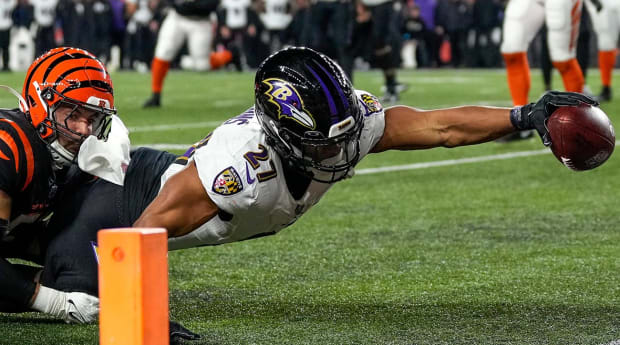I have been a running backs truther for as long as I can remember playing fantasy football. My first-ever draft pick in a draft came back in 1998, when I took Terrell Davis. I later traded for then-rookie Fred Taylor. Can you say championship? Since then, I’ve focused my early-round picks on runners. From Emmitt Smith, Barry Sanders, Marshall Faulk or LaDainian Tomlinson in the past to the likes of Ezekiel Elliott, Alvin Kamara or Austin Ekeler in more recent years, getting a couple of stud runners was always at the forefront of my fantasy roster build.
So, when the “Zero RB Strategy” was introduced by Shawn Siegele back in 2013, I scoffed at it. This philosophy is based on completely avoiding running backs in the first five rounds. Instead, the strategy says, fantasy managers should load up on wide receivers, a tight end and a quarterback. To me, it made zero sense. After all, backs have long been the lifeblood of fantasy football. Stud runners win fantasy leagues.
Why the hell would I avoid that?
In my opinion, the Zero RB strategy required a lot of luck. You had to hope that at least a few of the backs you drafted after the first five rounds panned out, and many times those lottery tickets ended up in the waiver wire garbage. If you didn’t land a breakout or sleeper runner on the wire either, well, your backfield was likely trash. In this scenario, a bad backfield was a fantasy death sentence.
Then, the 2022 season happened. A few of the backs we’ve leaned on for years, like Kamara, Elliott, Dalvin Cook and Leonard Fournette, saw their totals decline at some level. The consensus No. 1 pick, Jonathan Taylor, finished 33rd in points at the position, making it the third straight year the consensus top pick was a runner who failed to meet expectations. We also saw a further increase in confusing and frustrating backfield committees emerge around the league.
At the same time, wide receivers thrived.
Justin Jefferson, Ja’Marr Chase and CeeDee Lamb were among the young wideouts who were rising up stat sheets. A.J. Brown, Amon-Ra St. Brown, Jaylen Waddle and DeVonta Smith (to name a few) also thrived for fantasy fans. And while the position isn’t completely clear of injuries (Cooper Kupp), it’s far less likely that a receiver will suffer a long-term ailment compared to a running back. That’s part of the reason we are seeing so many runners holding out over current contractual issues while No. 2 and 3 wide receivers are getting paid at a much higher level.
This has been the perfect storm of sorts, and it’s created a shift in the importance of wideouts. In the high-stakes world of the NFFC, eight of the top 12 overall picks are wideouts and half of the picks in the top three rounds are receivers. It’s a different world, folks. We’re also seeing the elite fantasy quarterbacks, Patrick Mahomes, Josh Allen and Jalen Hurts, come off the board in the top three rounds.
When we include these factors, plus the emergence of Travis Kelce as a top-12 overall choice, we’re now seeing running backs getting pushed down draft boards. It’s created a scenario in which (I can’t believe I’m saying this), the Zero RB strategy is a more viable approach. While I’d much rather execute it in a 10-team league that starts one quarterback (no superflex) compared to a similar 12- or 14-team format, I have found myself pushing backs down the board and focusing on wide receivers in the first five rounds. Part of the reason I’m more comfortable with this strategy now is that good runners are going to be available later in drafts.

For example, upside backs like Breece Hall, Javonte Williams, Kenneth Walker, J.K. Dobbins and James Cook are falling into and beyond the fifth round. The same goes for Dameon Pierce, Alexander Mattison, Cam Akers and Miles Sanders. Heck, I can get James Conner at 78.2 on the NFFC site. I don’t see all of these players as what we call “lottery tickets,” either. Many of the aforementioned backs have nice ceilings and/or clear paths to workload for their respective teams.
So, while they’re ranked as low RB2s or flex starters in most leagues, there’s plenty of potential for these backs to move up into the low RB1 or high RB2 conversation. That’s a big part of the reason I’m now open to (and have actually utilized) the Zero RB strategy. With the trend of wideouts and quarterbacks rising in drafts, there are more attractive backs available in the middle and even the later rounds.
This strategy clearly isn’t for everyone, and I’d prefer to go “Hero RB” (drafting just one back in the first five rounds) in a 12- or 14-team league. But the bottom line, as much as I hate to admit it, is that running backs have lost their luster in both real and fantasy football. Much like Jedi master Yoda told Luke Skywalker in The Empire Strikes Back, don’t be afraid to unlearn what you have learned.







